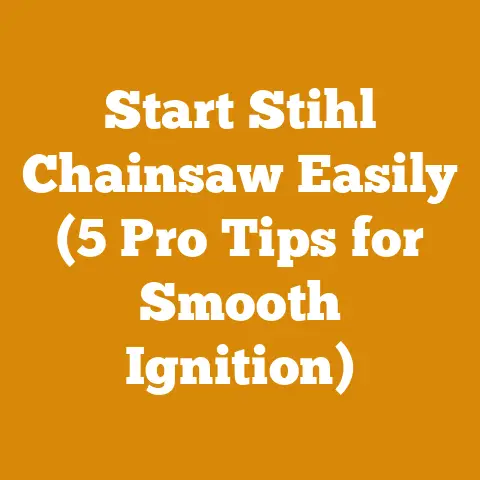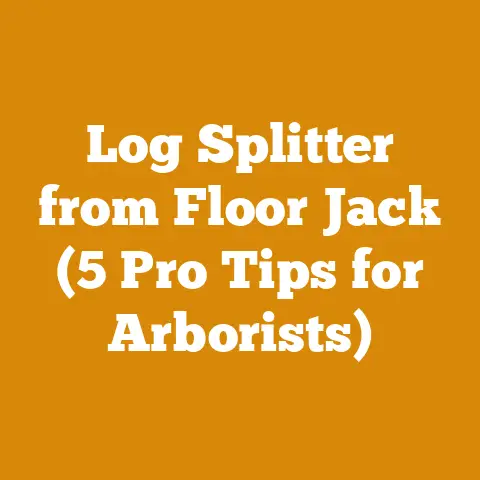Tree Stump Grinding Cost Guide (Pro Tips for Accurate Pricing)
Let’s face it, that unsightly tree stump in your yard is more than just an eyesore. It’s a tripping hazard, a potential home for pests, and a constant reminder of the tree that once was. But transforming that stump into a clean slate, ready for replanting or landscaping, is where the magic of tree stump grinding comes in. And understanding the cost involved is the first step in that transformation.
Tree Stump Grinding Cost Guide (Pro Tips for Accurate Pricing)
Understanding the Factors Influencing Stump Grinding Costs
The cost of tree stump grinding isn’t a one-size-fits-all equation. Several factors come into play, each contributing to the final price you’ll pay. Understanding these factors is crucial for getting an accurate estimate and avoiding surprises down the road.
- Stump Size: This is the most significant factor. Larger stumps require more time, effort, and machine power to grind down. The diameter of the stump, measured at its widest point, is the key measurement here.
- Stump Quantity: Grinding multiple stumps at once will often result in a lower per-stump price. Contractors can leverage economies of scale, making it more efficient to handle several stumps in a single visit.
- Stump Accessibility: Is the stump easily accessible with grinding equipment? Obstacles like fences, sheds, or steep slopes can make the job more challenging and increase the cost.
- Root System: A widespread and deep root system can significantly increase the grinding time and complexity. Some roots may extend far beyond the visible stump, requiring extra work.
- Wood Type: Harder wood species, like oak or maple, take longer to grind than softer woods like pine or poplar. The density of the wood directly impacts the grinding time and the wear and tear on the equipment.
- Location: Prices can vary significantly based on your geographic location. Areas with a higher cost of living or a greater demand for tree services will generally have higher prices.
- Contractor Experience and Reputation: Experienced and reputable contractors often charge more, but they also bring expertise, insurance, and a commitment to quality work.
- Additional Services: Do you need the contractor to remove the grindings (wood chips) after the job? This is an additional service that will add to the overall cost.
- Urgency: If you need the stump ground urgently, you may have to pay a premium for expedited service.
Decoding the Pricing Models: Per-Stump vs. Per-Inch vs. Hourly
Stump grinding contractors typically use one of three pricing models: per-stump, per-inch, or hourly. Let’s break down each model to help you understand which one might be the most advantageous for your situation.
- Per-Stump Pricing: This is the most straightforward model. The contractor provides a fixed price for grinding each stump, regardless of the time it takes. This model is often preferred for smaller projects with a few easily accessible stumps. It offers price certainty, allowing you to budget accordingly. However, it might not be the most cost-effective option for very large or complex stumps.
- Per-Inch Pricing: This model charges based on the diameter of the stump. For example, a contractor might charge $5-$10 per inch of stump diameter. This model is often used for larger stumps where the size is the primary factor influencing the grinding time. To calculate the estimated cost, measure the stump’s diameter at its widest point and multiply it by the per-inch rate. The challenge here is accurately estimating the diameter, especially for irregularly shaped stumps.
- Hourly Pricing: This model charges an hourly rate for the grinding service. This model is often used for complex jobs with difficult access, extensive root systems, or multiple stumps of varying sizes. While it can be the most flexible option, it also carries the risk of unexpected cost overruns if the job takes longer than anticipated. It’s crucial to get a clear estimate of the expected completion time and to monitor the progress of the work.
My Experience: I once had a client with three large oak stumps in their backyard. The stumps were located near a fence and a swimming pool, making access difficult. Several contractors quoted a per-stump price, which was quite high due to the complexity of the job. However, one contractor offered an hourly rate, explaining that it was difficult to estimate the exact time required due to the obstacles and the hard wood. In the end, the hourly rate proved to be the most cost-effective option, as the contractor worked efficiently and completed the job in less time than initially estimated.
Average Stump Grinding Costs: Data and Benchmarks
While the actual cost of stump grinding will vary depending on the factors discussed earlier, here are some average price ranges to give you a general idea of what to expect:
- Small Stumps (up to 12 inches in diameter): $75 – $150 per stump
- Medium Stumps (12-24 inches in diameter): $150 – $300 per stump
- Large Stumps (24-36 inches in diameter): $300 – $500 per stump
- Extra-Large Stumps (over 36 inches in diameter): $500+ per stump
Per-Inch Pricing: $5 – $10 per inch of diameter
Hourly Rate: $100 – $200 per hour
Data Point: According to a recent survey of tree service companies, the average cost of stump grinding in the United States is $318 per stump.
Important Note: These are just averages. Always get multiple quotes from local contractors to get the most accurate pricing for your specific situation.
Pro Tips for Getting Accurate Pricing
Getting an accurate estimate is crucial for avoiding unexpected costs and ensuring you get the best value for your money. Here are some pro tips to help you navigate the pricing process:
- Get Multiple Quotes: Contact at least three different contractors to get quotes. This will give you a better understanding of the market rate in your area and allow you to compare prices and services.
- Provide Detailed Information: The more information you provide to the contractor, the more accurate their estimate will be. Be sure to include the size, location, and wood type of the stump, as well as any potential obstacles.
- Ask About Additional Fees: Clarify whether the quote includes all costs, such as travel fees, disposal fees, or fees for grinding below ground level.
- Inquire About Insurance and Licensing: Ensure that the contractor is properly insured and licensed. This will protect you from liability in case of accidents or damage.
- Read Reviews and Check References: Check online reviews and ask for references from previous clients. This will give you an idea of the contractor’s reputation and quality of work.
- Get a Written Contract: Always get a written contract that outlines the scope of work, the price, the payment terms, and any guarantees.
- Negotiate: Don’t be afraid to negotiate the price. Contractors may be willing to offer discounts, especially if you’re hiring them for multiple services.
- Consider Off-Season Pricing: Tree service companies are often less busy during the off-season (typically winter), so you may be able to get a lower price.
- Be Present During the Estimate: Being present during the estimate allows you to ask questions, point out any potential challenges, and ensure the contractor understands your expectations.
- Understand the Depth of Grinding: Discuss with the contractor how deep they will grind the stump. Grinding deeper will allow you to plant grass or flowers directly over the area, while a shallower grind may only be suitable for mulch or gravel.
DIY Stump Grinding vs. Hiring a Professional: Weighing the Pros and Cons
You might be tempted to tackle stump grinding yourself to save money. While DIY stump grinding is possible, it’s important to weigh the pros and cons before making a decision.
DIY Stump Grinding:
Pros:
- Cost Savings: Renting a stump grinder can be cheaper than hiring a professional, especially for small stumps.
- Flexibility: You can work at your own pace and on your own schedule.
- Sense of Accomplishment: You get the satisfaction of completing the job yourself.
Cons:
- Safety Risks: Stump grinders are powerful and dangerous machines. Improper use can result in serious injury.
- Physical Demands: Stump grinding is physically demanding work.
- Time Commitment: It can take a significant amount of time to grind a stump, especially if you’re not experienced.
- Equipment Rental Costs: Renting a stump grinder can be expensive, and you may also need to purchase safety equipment.
- Potential Damage: You could damage your property or underground utilities if you’re not careful.
- Disposal of Grindings: You’ll need to find a way to dispose of the wood chips.
Hiring a Professional:
Pros:
- Safety: Professionals have the experience and equipment to grind stumps safely.
- Efficiency: Professionals can grind stumps quickly and efficiently.
- Convenience: You don’t have to do any of the work yourself.
- Insurance: Professionals are insured, so you’re protected from liability in case of accidents or damage.
- Expertise: Professionals can handle complex stump grinding situations.
- Proper Disposal: Professionals will typically remove and dispose of the wood chips.
Cons:
- Higher Cost: Hiring a professional is more expensive than DIY stump grinding.
- Scheduling: You’ll need to schedule the service in advance.
My Recommendation: Unless you have experience operating heavy machinery and are comfortable with the safety risks, I recommend hiring a professional for stump grinding. The cost savings of DIY stump grinding are often outweighed by the risks and the potential for damage.
Understanding the Stump Grinding Process: From Start to Finish
Knowing what to expect during the stump grinding process can help you prepare for the job and ensure a smooth experience. Here’s a step-by-step overview:
- Preparation: The contractor will clear the area around the stump of any obstacles, such as rocks, branches, or debris. They may also mark underground utilities to avoid damaging them.
- Equipment Setup: The contractor will position the stump grinder next to the stump. Stump grinders come in various sizes, ranging from small, walk-behind models to large, self-propelled machines.
- Grinding: The contractor will start the stump grinder and begin grinding the stump. The grinding wheel, which is equipped with sharp teeth, will chip away at the wood. The contractor will move the grinder back and forth across the stump, gradually reducing its size.
- Depth Adjustment: The contractor will adjust the depth of the grinding wheel as needed to grind the stump to the desired depth. Typically, stumps are ground 4-12 inches below ground level.
- Root Grinding: If necessary, the contractor will grind the visible roots extending from the stump.
- Cleanup: The contractor will remove the wood chips from the area and dispose of them properly. Some contractors offer to backfill the hole with topsoil.
- Inspection: The contractor will inspect the area to ensure that the stump has been ground to the desired depth and that the area is clean.
Data Point: A well-maintained stump grinder can remove approximately 1 cubic foot of wood per minute.
Choosing the Right Contractor: Key Considerations
Selecting the right contractor is crucial for a successful stump grinding project. Here are some key considerations to keep in mind:
- Experience: Look for a contractor with several years of experience in stump grinding.
- Reputation: Check online reviews and ask for references to gauge the contractor’s reputation.
- Insurance and Licensing: Ensure that the contractor is properly insured and licensed.
- Equipment: The contractor should have the appropriate equipment for the job.
- Pricing: Get multiple quotes and compare prices and services.
- Communication: The contractor should be responsive and communicate clearly.
- Professionalism: The contractor should be professional and courteous.
- Guarantees: Ask about any guarantees or warranties offered by the contractor.
- Local Knowledge: A contractor with local knowledge will be familiar with the soil conditions and potential challenges in your area.
- Commitment to Safety: The contractor should prioritize safety and follow proper safety procedures.
Negotiating Stump Grinding Costs: Strategies and Tactics
Negotiating the price of stump grinding can save you money. Here are some strategies and tactics to consider:
- Get Multiple Quotes: As mentioned earlier, getting multiple quotes is the best way to compare prices and negotiate a better deal.
- Bundle Services: If you need other tree services, such as tree trimming or removal, consider bundling them with stump grinding to get a discount.
- Offer to Help with Cleanup: If you’re willing to help with the cleanup, the contractor may be willing to lower the price.
- Pay in Cash: Some contractors offer discounts for cash payments.
- Negotiate the Depth of Grinding: Grinding the stump to a shallower depth can reduce the cost.
- Offer to Provide Access: If you can provide easy access to the stump, the contractor may be willing to lower the price.
- Highlight Competitor Quotes: If you have a lower quote from a competitor, use it as leverage to negotiate a better price.
- Be Polite and Respectful: A positive attitude can go a long way in negotiations.
- Don’t Be Afraid to Walk Away: If you’re not happy with the price, don’t be afraid to walk away. There are plenty of other contractors who would be happy to have your business.
- Ask About Seasonal Discounts: Tree service companies may offer discounts during the off-season.
Preparing Your Yard for Stump Grinding: A Checklist
Preparing your yard for stump grinding can help ensure a smooth and efficient process. Here’s a checklist:
- Clear the Area: Remove any obstacles from the area around the stump, such as rocks, branches, or debris.
- Mark Underground Utilities: Contact your local utility companies to mark any underground utilities in the area.
- Inform Neighbors: Let your neighbors know that you’ll be having stump grinding done.
- Provide Access: Ensure that the contractor has easy access to the stump.
- Protect Delicate Plants: Cover any delicate plants near the stump to protect them from damage.
- Keep Children and Pets Away: Keep children and pets away from the work area during the stump grinding process.
- Water the Area: Watering the area around the stump can help reduce dust.
- Remove Fences or Obstructions: If necessary, remove any fences or other obstructions that may interfere with the stump grinding process.
- Consider Soil Conditions: If the soil is very wet or muddy, it may be difficult to grind the stump.
Post-Stump Grinding: What to Do with the Grindings
After the stump has been ground, you’ll be left with a pile of wood chips. Here are some options for what to do with the grindings:
- Use as Mulch: The wood chips can be used as mulch around trees and shrubs.
- Compost: The wood chips can be added to your compost pile.
- Fill the Hole: The wood chips can be used to fill the hole left by the stump. However, be aware that the wood chips will decompose over time, so you may need to add more soil later.
- Remove and Dispose: You can remove the wood chips and dispose of them at a local landfill or recycling center.
- Offer to Neighbors: Your neighbors may be interested in using the wood chips as mulch.
- Leave for the Contractor: Some contractors will remove the wood chips as part of their service. Be sure to clarify this when getting a quote.
- Create a Path: Use the wood chips to create a natural path in your garden.
- Use as Animal Bedding: Wood chips can be used as bedding for animals, such as chickens or rabbits.
My Tip: If you plan to use the wood chips as mulch, let them sit for a few weeks to allow them to decompose slightly. This will help prevent them from drawing nitrogen from the soil.
Long-Term Cost Considerations: Preventing Future Stumps
While stump grinding addresses the immediate problem of an unsightly stump, it’s worth considering long-term strategies to prevent future stumps.
- Proper Tree Removal: When having a tree removed, ensure that the tree service company removes the entire tree, including the root ball. This will prevent the stump from regrowing.
- Choose the Right Tree Species: When planting new trees, choose species that are less prone to disease and decay.
- Proper Tree Care: Provide proper care for your trees, including watering, fertilizing, and pruning. This will help them stay healthy and strong.
- Regular Inspections: Inspect your trees regularly for signs of disease or decay.
- Prevent Root Damage: Avoid damaging the roots of your trees. This can weaken them and make them more susceptible to disease.
- Consider Tree Location: When planting new trees, consider their location. Avoid planting trees near underground utilities or structures.
- Use Root Barriers: If you’re concerned about tree roots damaging your property, consider using root barriers.
- Consult with an Arborist: Consult with a certified arborist for advice on tree care and maintenance.
Alternative Stump Removal Methods: Exploring Your Options
While stump grinding is the most common method of stump removal, there are other options to consider:
- Chemical Stump Removal: This involves using chemicals to accelerate the decomposition of the stump. However, this method can take several months or even years to complete.
- Burning: Burning a stump is a quick and effective method of removal, but it’s not allowed in all areas.
- Manual Removal: This involves digging around the stump and cutting the roots with an axe or saw. This is a labor-intensive method, but it can be effective for small stumps.
- Stump Pulling: This involves using a winch or tractor to pull the stump out of the ground. This method can be effective for larger stumps, but it can also damage the surrounding area.
- Natural Decomposition: You can simply let the stump decompose naturally over time. This is the least expensive option, but it can take many years for the stump to disappear completely.
My Insight: I’ve seen homeowners try the chemical stump removal route with mixed results. It can work, but it’s slow and requires patience. Plus, you need to be careful about the chemicals you’re using and their potential impact on the surrounding environment.
Case Study: Stump Grinding Project Breakdown
Let’s break down a real-world stump grinding project to illustrate the various cost factors:
Project: Grinding a 24-inch diameter oak stump in a residential backyard.
Challenges: The stump was located near a fence and had a moderate root system.
Contractor Quotes:
- Contractor A: $350 (per-stump)
- Contractor B: $8 per inch ($192 total)
- Contractor C: $150 per hour (estimated 2 hours = $300)
Analysis:
- Contractor B offered the lowest price based on per-inch pricing.
- Contractor C’s hourly rate was competitive, but there was a risk of cost overruns if the job took longer than estimated.
- Contractor A’s per-stump price was the highest.
Decision:
The homeowner chose Contractor B due to the lowest price.
Outcome:
The contractor completed the job in 2.5 hours. Contractor B honored the initial quote of $192. The homeowner was satisfied with the quality of the work.
Key Takeaways:
- Per-inch pricing can be advantageous for certain stump sizes.
- It’s important to get a clear understanding of the pricing model and potential risks.
Final Thoughts: Investing in a Stump-Free Landscape
Removing a tree stump is an investment in your property’s aesthetics, safety, and value. By understanding the factors that influence stump grinding costs, getting accurate pricing, and choosing the right contractor, you can transform that unsightly stump into a clean slate, ready for your landscaping vision. Remember to consider the long-term benefits of a stump-free landscape and the potential for future improvements.






